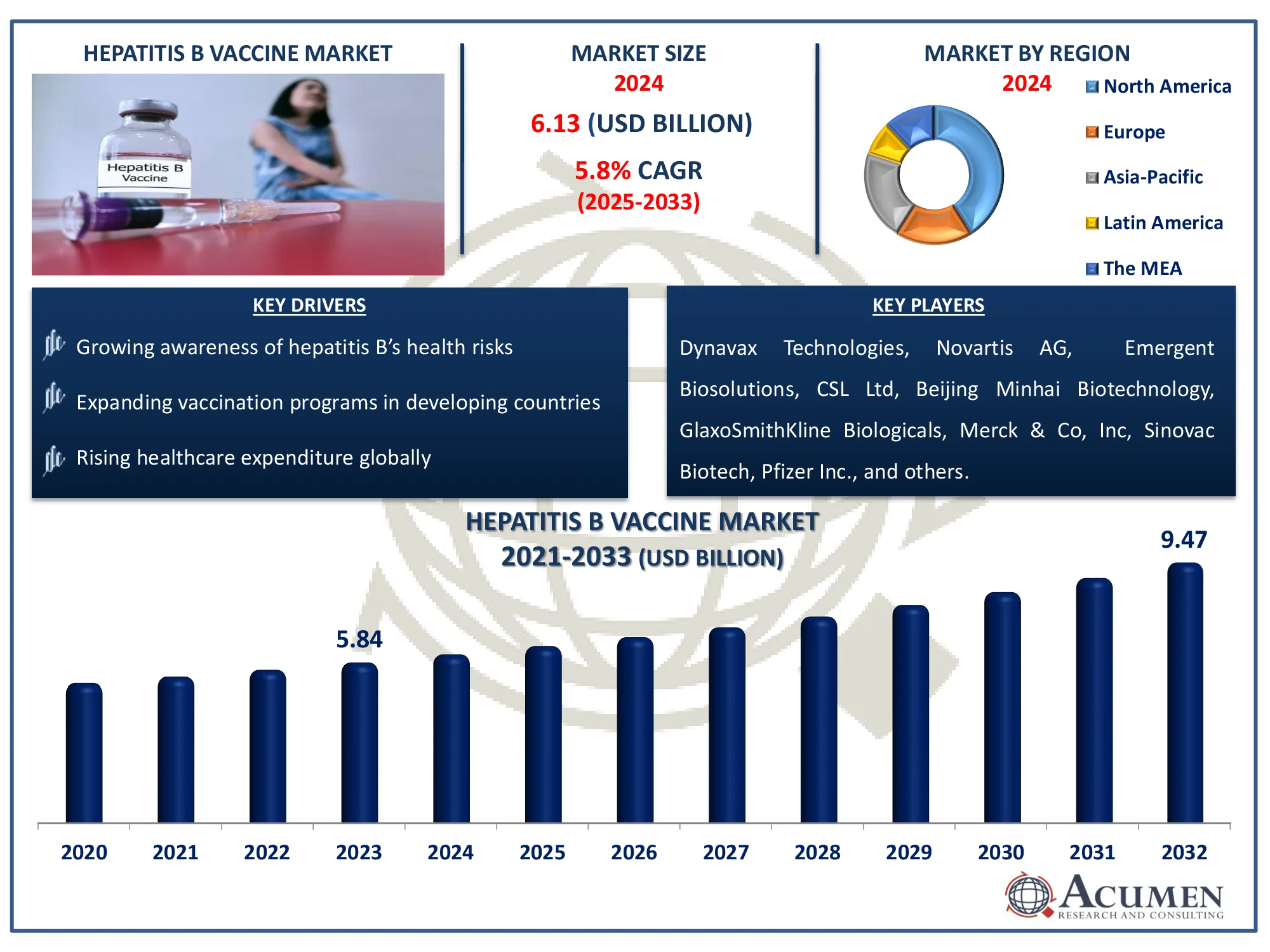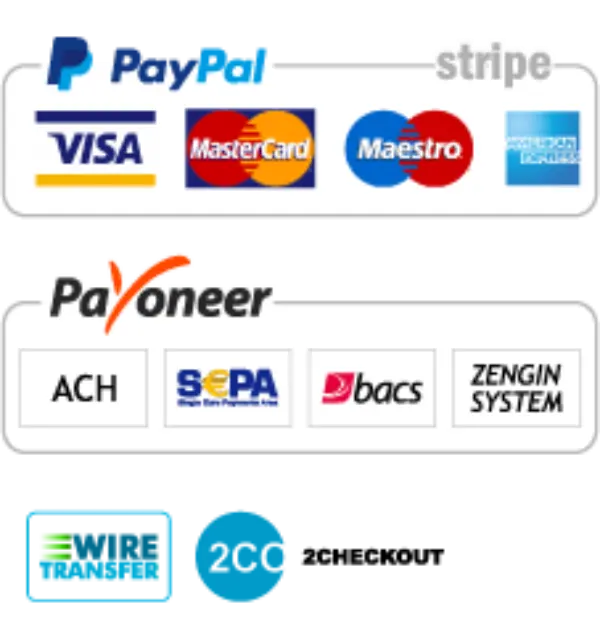Hepatitis B Vaccine Market Size - Global Industry, Share, Analysis, Trends and Forecast 2025 - 2033
Published :
Report ID:
Pages :
Format :
Hepatitis B Vaccine Market Size - Global Industry, Share, Analysis, Trends and Forecast 2025 - 2033
Report Coverage
- Industry Dynamics
- Market Size and Forecast Data
- Segment Analysis
- Competitive Landscape
- Regional Analysis with a Niche Focus on Country-Level Data
- High Level Analysis - Porter's, PESTEL, Value Chain, etc.
- Company Profiles of Key Players
- Option to Customize the Report As Per Your Specific Need
Request Sample Report
The Global Hepatitis B Vaccine Market Size accounted for USD 6.13 Billion in 2024 and is estimated to achieve a market size of USD 10.08 Billion by 2033 growing at a CAGR of 5.8% from 2025 to 2033.
Hepatitis B Vaccine Market Highlights
- The global hepatitis B vaccine market is projected to reach USD 10.08 billion by 2033, growing at a CAGR of 5.8% from 2025 to 2033
- According to the WHO, 3,500 people die daily worldwide due to hepatitis B and C infections
- The North America hepatitis B vaccine market was valued at USD 2.51 billion in 2024
- The Asia-Pacific region is expected to grow at a CAGR of over 6.3% from 2025 to 2033
- Combination vaccines dominated the market, accounting for 74% of the total share in 2024
- Hospitals were the leading end-user, holding 62% of the market share in 2024
- Increasing adoption of combination vaccines, particularly in developed countries is a popular market trend that fuels the industry demand
 The hepatitis B vaccination is intended to prevent HBV infection, a potentially fatal liver infection caused by the hepatitis B virus (HBV). It is deemed safe and effective, and both the World Health Organization (WHO) and the United States Centers for Disease Control and Prevention (CDC) recommend it for infants, children under the age of 18, and diabetics. It is also indicated for people who are at high risk of infection because to their job, living situation, lifestyle, or country of origin. Furthermore, the hepatitis B vaccine is commonly referred to as the first anti-cancer vaccine because it prevents hepatitis B, a major cause of liver cancer.
The hepatitis B vaccination is intended to prevent HBV infection, a potentially fatal liver infection caused by the hepatitis B virus (HBV). It is deemed safe and effective, and both the World Health Organization (WHO) and the United States Centers for Disease Control and Prevention (CDC) recommend it for infants, children under the age of 18, and diabetics. It is also indicated for people who are at high risk of infection because to their job, living situation, lifestyle, or country of origin. Furthermore, the hepatitis B vaccine is commonly referred to as the first anti-cancer vaccine because it prevents hepatitis B, a major cause of liver cancer.
Furthermore, current World Health Organization (WHO) predictions show that 254 million people would be infected with hepatitis B and 50 million with hepatitis C by 2022. People aged 30-54 account for half of the chronic hepatitis B and C infections, with 12% occurring in children under the age of 18. Men represent 58% of all cases. This increase in hepatitis B instances fuels the growth of the hepatitis B market since people require hepatitis B vaccines to be cured.
Global Hepatitis B Vaccine Market Dynamics
Market Drivers
- Growing awareness of hepatitis B’s health risks
- Expanding vaccination programs in developing countries
- Rising healthcare expenditure globally
- Technological advancements in vaccine development
Market Restraints
- High vaccine production costs
- Limited access to healthcare in remote areas
- Vaccine supply chain challenges
- Vaccine hesitancy in some populations
Market Opportunities
- Emerging markets with unmet vaccination needs
- Government initiatives to combat hepatitis B
- Partnerships for vaccine distribution in underserved regions
Hepatitis B Vaccine Market Report Coverage
|
Market |
Hepatitis B Vaccine Market |
|
Hepatitis B Vaccine Market Size 2024 |
USD 6.13 Billion |
|
Hepatitis B Vaccine Market Forecast 2033 |
USD 10.08 Billion |
|
Hepatitis B Vaccine Market CAGR During 2025 - 2033 |
5.8% |
|
Hepatitis B Vaccine Market Analysis Period |
2021 - 2033 |
|
Hepatitis B Vaccine Market Base Year |
2024 |
|
Hepatitis B Vaccine Market Forecast Data |
2025 - 2033 |
|
Segments Covered |
By Type, By Doses, By Age, By End-User, and By Geography |
|
Regional Scope |
North America, Europe, Asia Pacific, Latin America, and Middle East & Africa |
|
Key Companies Profiled Aviation |
Dynavax Technologies, Novartis AG, Emergent Biosolutions, Beijing Minhai Biotechnology, GlaxoSmithKline Biologicals, Merck & Co, Inc, CSL Ltd, Sinovac Biotech, Pfizer Inc., Sanofi Pasteur, Serum Institute of India, and Emergent Biosolutions. |
|
Report Coverage |
Market Trends, Drivers, Restraints, Competitive Analysis, Player Profiling, Covid-19 Analysis, Regulation Analysis |
Hepatitis B Vaccine Market Insights
The rising number of hepatitis B cases worldwide is the key driver of hepatitis B vaccine market expansion. Governments are launching programs to educate communities about the benefits of the hepatitis B vaccine. For example, on World Hepatitis Day in 2018, India's Ministry of Health and Family Welfare established the National Viral Hepatitis Control Programme, with the goal of eliminating HBV infections by 2032. In addition, rising healthcare spending in emerging economies is driving the hepatitis B market value. Furthermore, increasing R&D activities and the development of innovative products in the market are likely to generate significant opportunities throughout the forecast period.
Hepatitis B is a viral disease that can be transmitted from person to person and is growing more prevalent around the world. According to the World Health Organization's (WHO) 2024 Global Hepatitis Report, the number of deaths lost to viral hepatitis is growing. The disease is the world's second biggest infectious cause of mortality, accounting for 1.3 million deaths per year, the same number as tuberculosis, the top infectious killer. This trend is expected to contribute to the growth of the hepatitis B vaccine market, as increased concerns and the development of more effective therapies will generate opportunities. However, a lack of vaccines on the market will limit its expansion.
According to the WHO, treatment coverage in the Western Pacific Region, which accounts for 47% of hepatitis B deaths, is only 23% among those diagnosed, which is much too low to lower mortality rates. Bangladesh, China, Ethiopia, India, Indonesia, Nigeria, Pakistan, the Philippines, the Russian Federation, and Vietnam account for roughly two-thirds of the global burden of hepatitis B and C. Providing universal access to prevention, diagnosis, and treatment in these ten nations by 2025. As a result, the hepatitis B vaccine industry is expanding, highlighting the critical need for increased immunization coverage to lower the global disease burden.
On the other side, the high cost of vaccination therapy and medicine is likely to limit hepatitis B market growth over the projection period.
 Hepatitis B Vaccine Market Segmentation
Hepatitis B Vaccine Market Segmentation
The worldwide market for hepatitis B vaccine is split based on technology, doses, age, end-user, and geography.
Hepatitis B Vaccine Market By Type
- Single Antigen Hepatitis B Vaccine
- Combination Vaccines
According to hepatitis B Vaccine industry analysis, the worldwide hepatitis B vaccine market is classified into two segments depending on vaccine type: single antigen hepatitis B vaccines and combination vaccines. Within the type group, combination vaccines have dominated the market. Combination vaccinations have the most market share because they can protect against numerous strains of diseases. These vaccinations are primarily used to boost the immune response of newborn infants and immunocompromised individuals, providing protection against a variety of diseases.
Hepatitis B Vaccine Market By Doses
- 3-Dose Schedule
- 2-Dose Schedule
- Alternate Schedule
According to hepatitis B vaccine industry analysis, the 3-dose schedule hepatitis B vaccination has the biggest market share, and it is likely to hold that position during the projection period. The 3-dose schedule hepatitis B vaccine is expected to grow the fastest throughout this time, owing to increased product availability and research and development efforts by major market participants. Furthermore, the two-dose schedule hepatitis B vaccination is predicted to be the fastest-growing category between 2023 and 2032. This two-dose vaccination method provides a better chance of attaining seroprotection, which will have a long-term positive impact by increasing compliance, leading in a reduced infection rate and more cost-effectiveness.
Hepatitis B Vaccine Age
- Pediatrics
- Adults
According to hepatitis B vaccine industry analysis, in recent years, the pediatric segment controls market due to obligatory immunization programs, government initiatives, and WHO guidelines for newborn vaccination at birth. Most nations have introduced the Hepatitis B vaccine into their national immunization regimens, resulting in a strong demand for pediatric doses. Furthermore, neonates and infants are particularly prone to chronic hepatitis B infections, hence early vaccination is critical for disease prevention. The adult segment is constantly growing due to rising awareness, occupational vaccines (e.g., healthcare professionals), and the rising prevalence of hepatitis B among high-risk populations.
Hepatitis B Vaccine End-user
- Hospitals
- Clinics
- Others
According to hepatitis B vaccine market forecast, the hospitals category dominated the global market with a considerable share, and it is likely to keep this dominance throughout the forecast period from 2025 to 2033. This area has the potential for growth due to the large number of products supplied in hospitals. Furthermore, the clinics segment is predicted to develop the fastest throughout the projection period of 2025–2033. The growing number of private clinics in Asia-Pacific and Latin America is expected to add to the segment's favorable growth.
Hepatitis B Vaccine Market Regional Outlook
North America
- U.S.
- Canada
Europe
- U.K.
- Germany
- France
- Spain
- Rest of Europe
Asia-Pacific
- India
- Japan
- China
- Australia
- South Korea
- Rest of Asia-Pacific
Latin America
- Brazil
- Mexico
- Rest of LATAM
The Middle East & Africa
- South Africa
- GCC Countries
- Rest of the Middle East & Africa (ME&A)
 Hepatitis B Vaccine Market Regional Analysis
Hepatitis B Vaccine Market Regional Analysis
In terms of regional segments, in recent years, North America has always dominated the hepatitis B vaccine industry in terms of sales. This increase could be attributed to the increased prevalence of hepatitis B disease. Health concerns in the United States have boosted demand for the hepatitis B vaccine, fueling regional market development. Key corporations expanded this industry through collaboration and partnership in multiple locations. For example, in September 2022, Valneva SE. and US-based VBI Vaccines Inc. established cooperation to market and distribute the PreHevbri vaccine in key European regions.
Europe follows closely after, accounting for the second-largest revenue share in the hepatitis B vaccine market. This increase can be related to the increased protection of newborn neonates against hepatitis B infection. Rising demand for hepatitis B vaccines in Europe is likely to drive future market expansion.
On the other hand, the Asia-Pacific region is seeing the most rapid growth in the hepatitis B vaccine market. China, in particular, is experiencing an increase in illness prevalence, which has been accompanied by increasing government financing and assistance from major actors, as well as expanded vaccine manufacture. Furthermore, increased partnerships for the development of innovative vaccines are expected to be important drivers of market growth in the Asia-Pacific region.
Hepatitis B Vaccine Market Players
Some of the top hepatitis B vaccine companies offered in our report includes Dynavax Technologies, Novartis AG, Emergent Biosolutions, Beijing Minhai Biotechnology, GlaxoSmithKline Biologicals, Merck & Co, Inc, CSL Ltd, Sinovac Biotech, Pfizer Inc., Sanofi Pasteur, Serum Institute of India, and Emergent Biosolutions.
Frequently Asked Questions
What was the market size of the global Hepatitis B Vaccine in 2024?
The market size of hepatitis B vaccine was USD 6.13 billion in 2024.
What is the CAGR of the global Hepatitis B Vaccine market from 2025 to 2033?
The CAGR of hepatitis B vaccine is 5.8% during the analysis period of 2025 to 2033.
Which are the key players in the Hepatitis B Vaccine market?
The key players operating in the global market are including Dynavax Technologies, Novartis AG, Emergent Biosolutions, Beijing Minhai Biotechnology, GlaxoSmithKline Biologicals, Merck & Co, Inc, CSL Ltd, Sinovac Biotech, Pfizer Inc., Sanofi Pasteur, Serum Institute of India, and Emergent Biosolutions.
Which region dominated the global Hepatitis B Vaccine market share?
North America held the dominating position in hepatitis B vaccine industry during the analysis period of 2025 to 2033.
Which region registered fastest CAGR from 2025 to 2033?
Asia-Pacific region exhibited fastest growing CAGR for market of Hepatitis B Vaccine during the analysis period of 2025 to 2033.
What are the current trends and dynamics in the global Hepatitis B Vaccine industry?
The current trends and dynamics in the hepatitis B vaccine industry include growing awareness of hepatitis B’s health risks, expanding vaccination programs in developing countries, rising healthcare expenditure globally, and technological advancements in vaccine development
Which type held the maximum share in 2024?
The combination vaccines held the maximum share of the hepatitis B vaccine industry.


